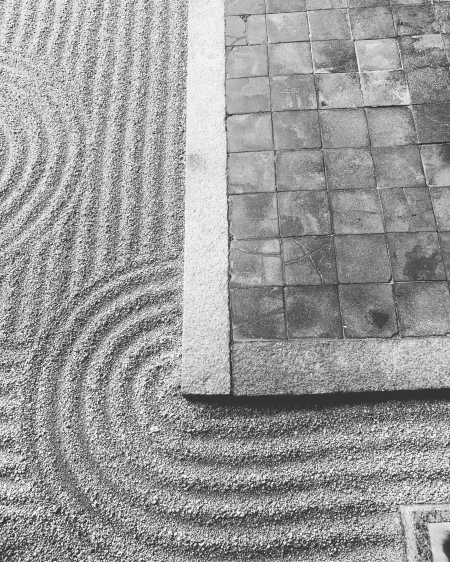仏像のお顔と幾何学形態
なぜ仏像のお顔が、例えば、大日如来像のお顔が、見る時々によって受ける印象が違うのかを考えている。きっとそれを考えていると、変化はしないけれど、その時々で建築の見え方が違うように思えることができるのではないか、その答えが見つかるかもしれない。
以前に考えた時は、確か、不完全性と汎用性があるからかもしれないと思った。
不完全性は、仏像のお顔はそこに何か見る人が足すことができる余地があり、それはちょうど建築で言うと、床の間のような存在であり、床の間は一見それ自体で完成しているが、そこに掛け軸やお花や器を足すことで、季節感や想いなどを表現でき、その床の間は見る人によって受ける印象が違う。
仏像のお顔に実際に何か物を足すことは無いが、見る人が勝手に想像力を駆使して、お顔の表情に足してしまう。それは、むしろ見る人が足すことによって仏像のお顔が成立するという意味で不完全性を纏っている。
汎用性は、その仏像のお顔がどのようにでも解釈できるということである。想像力を駆使して表情に何か足してしまう時に制限が無い、どのようにでも変化して見える、喜怒哀楽のどのようにでも、また、その境目も無い、笑っているようでも、哀しんでいるようでも、その両方の要素も併せ持つような表情にも見える。
どうして、このような不完全性と汎用性を備えることができるのだろう。例えば、明確な表情を持ったお顔ならば、そうはならない。例えば、明確な視線がある、目の動きがある、口角や眉の角度で何かを表現してしまっているなど、はっきりと何かを主張している訳ではないからか。
ここで、頭を過ぎるのは幾何学形態、一見完成されているように見えるが、その単純な形態の組合せには、何か別の幾何学形態を足すことも可能であるという意味で不完全性があり、その単純な形態の組合せはどのような建築にも対応ができるという意味で汎用性があり、そして、その足す部分は装飾にもなり、例えば、それは縄文式土器のように、その時々の表現が可能でもある。
ならば、仏像のお顔を幾何学形態として捉えて、それはデッサンのはじめのように、構造的に物体を捉えて、幾何学形態に分解して見ていくと、この不完全性と汎用性の正体がわかるのか。
"Face of Buddha statue and geometric form"
I'm thinking about why the face of a Buddha statue, for example, the face of a Dainichi Nyorai statue, has a different impression depending on when you look at it. If you think about it, it doesn't change, but you may be able to find the answer to how architecture may look different at different times.
When I thought about it earlier, I thought it might be because of incompleteness and versatility.
Imperfection is that the face of the Buddha statue has room for the viewer to add something to it, just as in architecture, between the floors, and between the floors is seemingly completed by itself However, by adding scrolls, flowers, and vessels, you can express the feeling of the season and your feelings.
Nothing is actually added to the face of the Buddha statue, but the viewer uses his or her imagination to add it to the facial expression. It is imperfect in the sense that the face of a Buddha statue is formed by the addition of a viewer.
Versatility means that the face of the Buddha statue can be interpreted in any way. There is no limit when I use my imagination to add something to my expression, it looks like it changes in any way, no way of emotions and sorrows, no boundaries, no laughing, no pity It looks like it has a combination of both elements.
How can such imperfection and versatility be provided? For example, if your face has a clear expression, this is not the case. For example, they do not clearly state something, such as having a clear gaze, eye movement, or expressing something with the angle of the mouth or eyebrow.
Here, beyond the head is a geometric form, which appears to be complete, but the combination of its simple forms is incomplete in the sense that it is possible to add some other geometric form The simple combination of forms is versatile in the sense that it can be adapted to any architecture, and its addition is also a decoration, for example, it is like a Jomon pottery, Sometimes expression is possible.
Then, the face of the Buddha statue is regarded as a geometrical form, and as at the beginning of the drawing, the object is structurally captured and decomposed into a geometrical form. Do you know the identity of?

